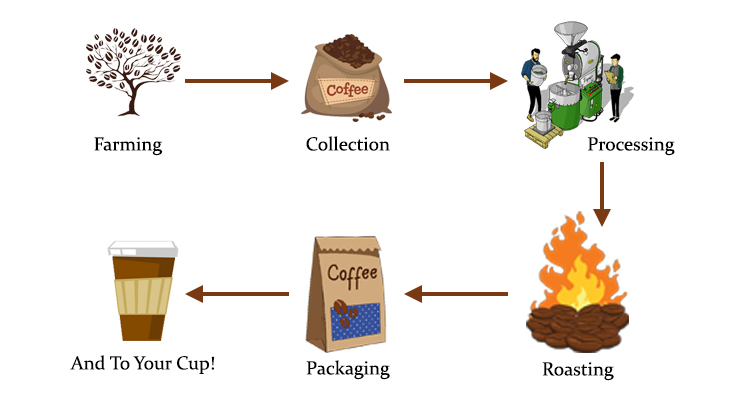Want To Learn How To Make Coffee Like A Pro?
If you are looking for barista training, you have landed to the right place.
Enter your details below
So, keeping the same thing in mind, in this blog, we’re going to discuss about coffee farming in Nepal and coffee processing methods.
History of Coffee Production in Nepal
Coffee was first produced in Nepal in the year 1938 AD. A gentleman named Santa Hira Giri imported coffee seeds from Burma, and planted it in Aapchaur village, in Gulmi district.Despite his initiation back in the days, it was only in 1975 AD when coffee production in Nepal started commercially, after coffee production and trading got extremely popular all over the world.
Various governmental organizations like National Tea and Coffee Development Board, along with National Tea and Coffee Development Department, under Agricultural Development Ministry, have been working to amplify coffee production and trade in Nepal since 1993 AD. They are working alongside 26000 coffee farmers across Nepal, INGOs like Helvetas Swiss Intercooperation Nepal and Winrock International Nepal, and associations like National Coffee Producers’ Association and Coffee Cooperative Union Limited to boost coffee’s production and trade in Nepal.
Currently, Coffee farming in Nepal is done in around 40 districts, which include Gulmi, Baglung, Lalitpur, Kavre, Ilam, Dhankuta, and so on. And from these areas, the final product is managed and distributed collectively by the joint efforts of the organizations mentioned above.
Coffee Production in Nepal
The districts where coffee is grown in Nepal are all in the hilly region, as the altitude between 800 m to 1600 m is considered the best for growing coffee. The land area where coffee is grown has to be a little sloped, as plain land often has chances of water accumulation, which can absolutely destroy coffee plant. Also, frosty weather is the arch nemesis of coffee plant, so, either the land area chosen for coffee production shouldn’t have such weather conditions, or efforts should be put to protect coffee from such weather conditions.
 Coffee plant is one of the most high maintenance plants out there. To get the best quality coffee, the plants need to be given utmost attention. The coffee planting process starts one year before the farmer actually plants the coffee. It all starts by planting fast growing trees like White Siris, Lead Tree and so on in the coffee production field. Their purpose is to offer shade to the coffee, and prevent frosty weather from destroying the plant.
Coffee plant is one of the most high maintenance plants out there. To get the best quality coffee, the plants need to be given utmost attention. The coffee planting process starts one year before the farmer actually plants the coffee. It all starts by planting fast growing trees like White Siris, Lead Tree and so on in the coffee production field. Their purpose is to offer shade to the coffee, and prevent frosty weather from destroying the plant.
The coffee plant is quite vulnerable to pests, so, to protect it natural fertilizer, which is a mixture of cow dung, ash and water, needs to be applied on the trunk and the branches. The height of coffee plant shouldn’t exceed seven feet, so proper trimming is required from time to time. Trimming is also used to get rid of dried, diseased and pest affected branches, which adversely impact the growth of the plant.
Coffee plant starts producing the fruit 5 years after its plantation. It is considered to be most productive from 7 years of age to 20 years of age. The harvest period occurs once in a year, and that is when the farmers pick only the bright red coffee cherries from the coffee plant. The harvested fruit is then taken to pulping center for processing.
Want To Learn How To Make Coffee Like A Pro?
If you are looking for barista training, you have landed to the right place.
Enter your details below
Coffee Processing Method
The coffee cherries are first washed thoroughly in clean water. Then, they are passed through a pulping machine that separates the coffee beans from the fruit. The coffee beans are then stored separately, and allowed to be fermented. After the fermentation process, the coffee beans are washed again a couple of times. Finally, it is left to be dried, first in the shade, for two to three days, and then in the sun, for a couple of days more. After all this processing, the coffee beans is finally ready to be packed and distributed.
 The produced coffee is then bought by different companies, packed and sold under their label. A large amount of coffee is also exported abroad. The coffee beans produced in Nepal are considered to be of a great quality, especially due to its distinct taste and aroma.
The produced coffee is then bought by different companies, packed and sold under their label. A large amount of coffee is also exported abroad. The coffee beans produced in Nepal are considered to be of a great quality, especially due to its distinct taste and aroma.
For consumption, these coffee beans need to roasted and grounded. Now, one could either buy the already roasted coffee beans, or the non-roasted ones. It’s always great to roast and grind the coffee oneself. Organic ground coffee are also available in the market.
So, the next time you order a cup of coffee for yourself, and the people accompanying you, think about the level of effort that is put into producing coffee, and bringing it all the way from the field to this cafe. By buying and consuming organic coffee, we play a huge role in stabilizing the market of coffee in Nepal. We make a small yet significant contribution to the sector of coffee production in Nepal.
Himalayan Coffee Trading is a company that offers the best organic coffee, and the most popular coffee making machines in Nepal. Himalayan Coffee Trading started as an organization that created awareness about the differences between organic and instant coffee. Currently, apart from selling organic coffee and coffee making machines, Himalayan Coffee Trading offers training on how to make coffee like a professional barista, by using the coffee making machines.
Want To Learn How To Make Coffee Like A Pro?
If you are looking for barista training, you have landed to the right place.
Enter your details below


[…] was only in 1975, when the commercial trading of coffee around the world became extremely popular, that Nepal became […]